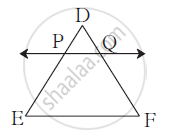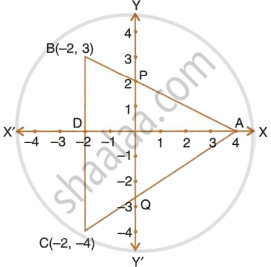Advertisements
Advertisements
Question
Find the point on the X–axis which is equidistant from A(–3, 4) and B(1, –4).
Solution
Let point C be on the X-axis which is equidistant from points A and B.
Point C lies on X-axis.
∴ Its y co-ordinate is 0.
Let C = (x, 0)
C is equidistant from points A and B.
∴ AC = BC
According to distance formula,
`∴ sqrt([x – (– 3)]^2 + (0 – 4)^2] = sqrt((x – 1)^2 + [0 – ( – 4)]^2)`
∴ [x – (– 3)]2 + (0 – 4)2 = (x – 1)2 + [0 – ( – 4)]2 ...(Squaring both the sides)
∴ (x + 3)2 + (– 4)2 = (x – 1)2 + 42
∴ x2 + 6x + 9 + 16 = x2 – 2x + 1 + 16
∴ `cancelx^2 + 6x + 25 = cancelx^2 – 2x + 17`
∴ 6x + 2x = 17 – 25
∴ 8x = – 8
∴ `"x" = (-8)/8`
∴ x = –1
∴ The point on the X-axis, which is equidistant from points A and B, is (–1, 0).
APPEARS IN
RELATED QUESTIONS
Write the equation of the line passing through the pair of points (2, 3) and (4, 7) in the form of y = mx + c.
Write the equation of each of the following lines:
- The x-axis and the y-axis.
- The line passing through the origin and the point (-3, 5).
- The line passing through the point (-3, 4) and parallel to X-axis.
Find the slope and y-intercept of the line:
ax – by = 0
Find the slope and y-intercept of the line:
3x – 4y = 5
Find the equation of the line passing through (−2, 1) and perpendicular to 4x + 5y = 6.
B(−5, 6) and D(1, 4) are the vertices of rhombus ABCD. Find the equations of diagonals BD and AC.
- Write down the equation of the line AB, through (3, 2) and perpendicular to the line 2y = 3x + 5.
- AB meets the x-axis at A and the y-axis at B. Write down the co-ordinates of A and B. Calculate the area of triangle OAB, where O is the origin.
The points A, B and C are (4, 0), (2, 2) and (0, 6) respectively. Find the equations of AB and BC. If AB cuts the y-axis at P and BC cuts the x-axis at Q, find the co-ordinates of P and Q.
A (5, 4), B (–3,–2) and C (1,–8) are the vertices of a triangle ABC. Find the equation of median AD and line parallel to AB passing through point C.
Show that points P(2, –2), Q(7, 3), R(11, –1) and S (6, –6) are vertices of a parallelogram.

In Δ DEF, line PQ || side EF, If DP = 2.4,
PE = 7.2, DQ = 1 then find QF.
Find the equation of the line that has x-intercept = –3 and is perpendicular to 3x + 5y = 1.
A straight line passes through the points P(–1, 4) and Q(5, –2). It intersects x-axis at point A and y-axis at point B. M is the mid-point of the line segment AB. Find:
- the equation of the line.
- the co-ordinates of point A and B.
- the co-ordinates of point M.
Find the equation of the line through the points A(–1, 3) and B(0, 2). Hence, show that the point A, B and C(1, 1) are collinear.
Three vertices of a parallelogram ABCD taken in order are A(3, 6), B(5, 10) and C(3, 2), find:
- the co-ordinates of the fourth vertex D.
- length of diagonal BD.
- equation of side AB of the parallelogram ABCD.
In the figure, given, ABC is a triangle and BC is parallel to the y-axis. AB and AC intersect the y-axis at P and Q respectively.

- Write the co-ordinates of A.
- Find the length of AB and AC.
- Find the radio in which Q divides AC.
- Find the equation of the line AC.
Find the equation of the line passing through the points (4,-5) and (-1,-2).
